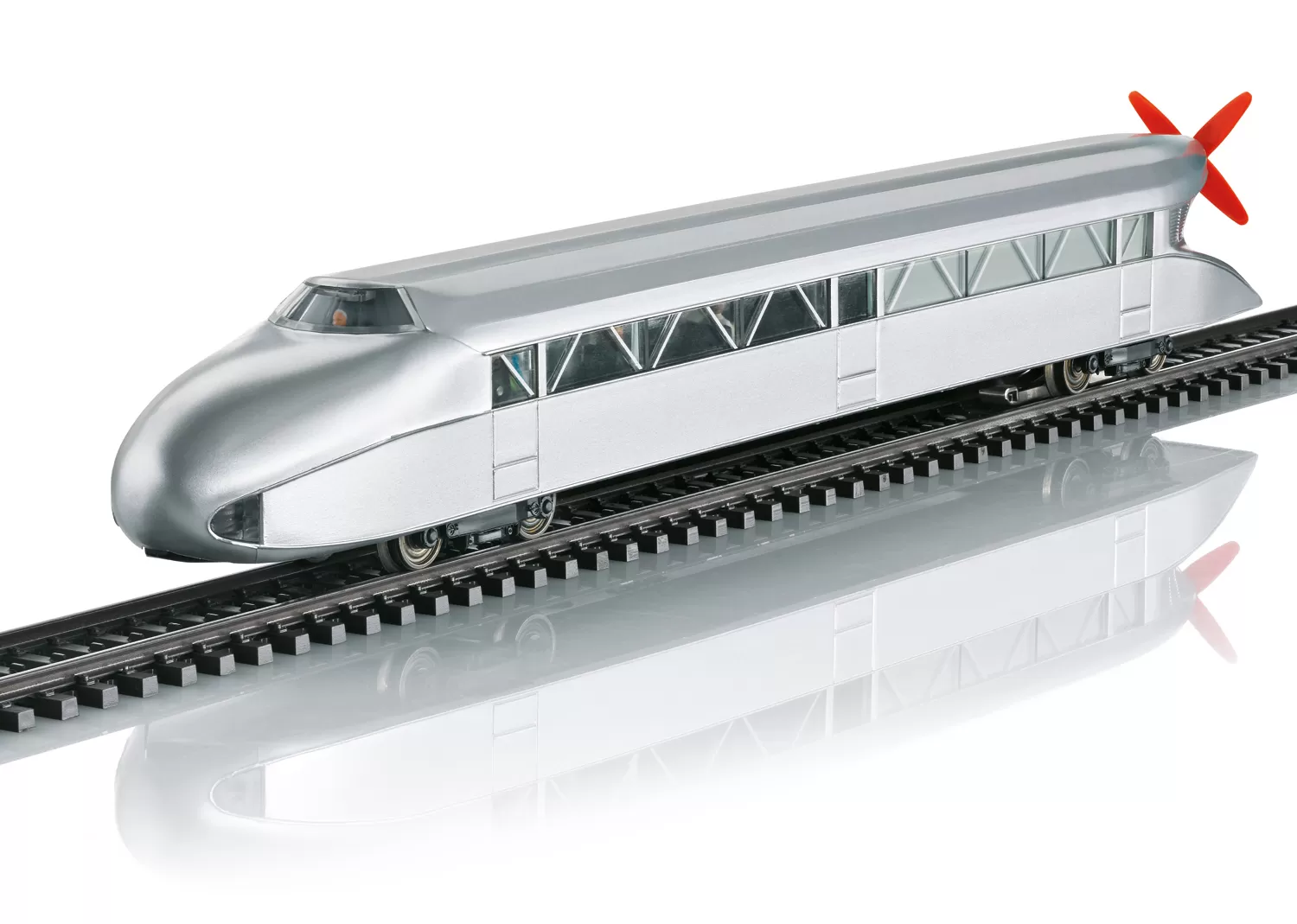Rail Zeppelin
Airplane Technology on Rails
In the Twenties of the previous century, aeronautical engineer Franz Kruckenberg, born in Uetersen, Germany in 1882, had the vision of fast railroad passenger service with propeller-driven railroad cars. The plans developed by him were based on lightweight airplane technology and reached their peak on June 21, 1931 in a triumphant record run by his streamlined Rail Zeppelin. It reached 233 km/h / 146 mph, a speed record for powered railroad cars that stood for 23 years. The principle of propeller-driven railroad cars proved to be less than ideally suited during test runs. Yet, Kruckenberg laid the foundation for modern, lightweight high-speed rail cars with the Rail Zeppelin and axle-powered successor designs developed by him. The Rail Zeppelin was and still is a legend and synonym for the rapid progress in railroad technology that has reached its peak in the present with the current high-speed powered rail car train technology.
Prototype: Propeller-driven Kruckenberg Rail Zeppelin. A legendary classic of the Thirties.
Highlights:
- retro packaging inspired by the historic packaging;
- mfx digital decoder with extensive sound functions;
- white LED headlights / red marker light, which changes over with the direction of travel;
- first time with a marker light;
- factory-installed LED interior lighting;
- cab lighting can be controlled digitally;
- powered propeller on the rear of the unit can be controlled digitally;
- figure of a locomotive engineer in the cab;
- interior has miniature figures as passengers.
Model: Reproduction of a Märklin classic. The unit has an mfx digital decoder with extensive sound functions. It also has built-in interior lighting as well as dual headlights and a red marker light that will work in conventional operation and can be controlled digitally. Maintenance-free warm white and red LEDs are used for the lighting. The propeller in the rear can be controlled digitally and will work in conventional operation. During switching maneuvers and going in reverse, an electric motor can be heard and the propeller is off. There is a figure of a locomotive engineer in the cab. The interior has miniature figures as passengers.
Vehicle length approximately 28.5 cm / 11-1/4".
Prototype information: Gasoline/benzene as well as diesel motors had certainly been discovered long before, but truly mature application of them in rail service had to wait until the end of the Twenties / beginning of the Thirties, whereby many missteps were made. The engineer Franz Kruckenberg, a former airship builder, and Curt Stedefeld came close to the goal. By 1930, they had put together a fast propeller powered rail car with the nickname "Rail Zeppelin" in Hannover. This silver-painted vehicle with an intentional similarity to a Zeppelin on rails ran on only two single-axle sets of running gear. Its rear was flattened for streamlining and the most remarkable thing to strike the observer about it was the large, double-blade propeller on its upper area, which was driven by a twelve-cylinder aircraft motor from BMW with 600 horsepower, mounted on the rear. An astonishing advantage when in operation was that the propeller allowed smooth and thereby ideal speed control by simply stepping on the gas. Since there was no gearbox or other weight, it was possible to build the 25.85 meter / 84 foot unit using lightweight methods. It only weighed 18.6 metric tons and accommodated 40 people. After the first test runs in the Hannover area, Kruckenberg wanted to test this propeller car once on a longer line in fast service. He thus stood ready in the early morning hours of June 21, 1931 in Hamburg-Bergedorf around 3:27 AM for the departure to Berlin. The route between Hamburg and Berlin was considered in 1931 by the DRG as one of the fastest lines, since it had a mostly straight course and hardly any grades worth mentioning. After the departure, the speedometer dial quickly swung between 150 to 180 km/h / 94 to 113 mph on the open stretch of track. Soon, the 200 km/h / 125 mph mark was also passed and over a distance of about twelve kilometers, the car raced between Karstädt and Dergenthin at the peak of 230.2 km/h / 144 mph! This was a record! At around 5:05 AM after a running time of 1 hour, 38 minutes and 19 seconds, it finally rolled up to the platform at the Spandau West station. The "Berliner Tageblatt" newspaper then observed, "Rail Zepp faster than an airplane, Hamburg – Berlin in 102 minutes". In any event, the average speed of this record run at 157.3 km/h / 98 mph was impressive. Starting in August of 1932, this experimental vehicle was completely rebuilt, because it quickly became apparent that the propeller drive was not usable on a conventional railroad network. The BMW motor was now moved to the front of the vehicle and there it was geared to a freshly installed two-axle truck using a Föttinger System hydraulic transmission for forward and reverse running. Several experimental runs were done with the hydraulic transmission after the vehicle had been sold to the DRG in November of 1934. The vehicle then remained in storage and it was scrapped in the spring of 1939 without further ado.
In the Twenties of the previous century, aeronautical engineer Franz Kruckenberg, born in Uetersen, Germany in 1882, had the vision of fast railroad passenger service with propeller-driven railroad cars. The plans developed by him were based on lightweight airplane technology and reached their peak on June 21, 1931 in a triumphant record run by his streamlined Rail Zeppelin. It reached 233 km/h / 146 mph, a speed record for powered railroad cars that stood for 23 years. The principle of propeller-driven railroad cars proved to be less than ideally suited during test runs. Yet, Kruckenberg laid the foundation for modern, lightweight high-speed rail cars with the Rail Zeppelin and axle-powered successor designs developed by him. The Rail Zeppelin was and still is a legend and synonym for the rapid progress in railroad technology that has reached its peak in the present with the current high-speed powered rail car train technology.
Prototype: Propeller-driven Kruckenberg Rail Zeppelin. A legendary classic of the Thirties.
Highlights:
- retro packaging inspired by the historic packaging;
- mfx digital decoder with extensive sound functions;
- white LED headlights / red marker light, which changes over with the direction of travel;
- first time with a marker light;
- factory-installed LED interior lighting;
- cab lighting can be controlled digitally;
- powered propeller on the rear of the unit can be controlled digitally;
- figure of a locomotive engineer in the cab;
- interior has miniature figures as passengers.
Model: Reproduction of a Märklin classic. The unit has an mfx digital decoder with extensive sound functions. It also has built-in interior lighting as well as dual headlights and a red marker light that will work in conventional operation and can be controlled digitally. Maintenance-free warm white and red LEDs are used for the lighting. The propeller in the rear can be controlled digitally and will work in conventional operation. During switching maneuvers and going in reverse, an electric motor can be heard and the propeller is off. There is a figure of a locomotive engineer in the cab. The interior has miniature figures as passengers.
Vehicle length approximately 28.5 cm / 11-1/4".
Prototype information: Gasoline/benzene as well as diesel motors had certainly been discovered long before, but truly mature application of them in rail service had to wait until the end of the Twenties / beginning of the Thirties, whereby many missteps were made. The engineer Franz Kruckenberg, a former airship builder, and Curt Stedefeld came close to the goal. By 1930, they had put together a fast propeller powered rail car with the nickname "Rail Zeppelin" in Hannover. This silver-painted vehicle with an intentional similarity to a Zeppelin on rails ran on only two single-axle sets of running gear. Its rear was flattened for streamlining and the most remarkable thing to strike the observer about it was the large, double-blade propeller on its upper area, which was driven by a twelve-cylinder aircraft motor from BMW with 600 horsepower, mounted on the rear. An astonishing advantage when in operation was that the propeller allowed smooth and thereby ideal speed control by simply stepping on the gas. Since there was no gearbox or other weight, it was possible to build the 25.85 meter / 84 foot unit using lightweight methods. It only weighed 18.6 metric tons and accommodated 40 people. After the first test runs in the Hannover area, Kruckenberg wanted to test this propeller car once on a longer line in fast service. He thus stood ready in the early morning hours of June 21, 1931 in Hamburg-Bergedorf around 3:27 AM for the departure to Berlin. The route between Hamburg and Berlin was considered in 1931 by the DRG as one of the fastest lines, since it had a mostly straight course and hardly any grades worth mentioning. After the departure, the speedometer dial quickly swung between 150 to 180 km/h / 94 to 113 mph on the open stretch of track. Soon, the 200 km/h / 125 mph mark was also passed and over a distance of about twelve kilometers, the car raced between Karstädt and Dergenthin at the peak of 230.2 km/h / 144 mph! This was a record! At around 5:05 AM after a running time of 1 hour, 38 minutes and 19 seconds, it finally rolled up to the platform at the Spandau West station. The "Berliner Tageblatt" newspaper then observed, "Rail Zepp faster than an airplane, Hamburg – Berlin in 102 minutes". In any event, the average speed of this record run at 157.3 km/h / 98 mph was impressive. Starting in August of 1932, this experimental vehicle was completely rebuilt, because it quickly became apparent that the propeller drive was not usable on a conventional railroad network. The BMW motor was now moved to the front of the vehicle and there it was geared to a freshly installed two-axle truck using a Föttinger System hydraulic transmission for forward and reverse running. Several experimental runs were done with the hydraulic transmission after the vehicle had been sold to the DRG in November of 1934. The vehicle then remained in storage and it was scrapped in the spring of 1939 without further ado.
First announced: January 2021
Presented in the following catalogs / brochures:
Recommended retail price: 329.00 €

3-rail (alternating current - AC)

DCC (Digital)

mfx digital decoder

Integrated sound

Double headlights and two red taillights alternating with the direction of travel

One red taillight

Interior LED lighting

Locomotive - metal frame

Length over buffers
285 mm

Miniature figures as passengers included
Discussion forum





